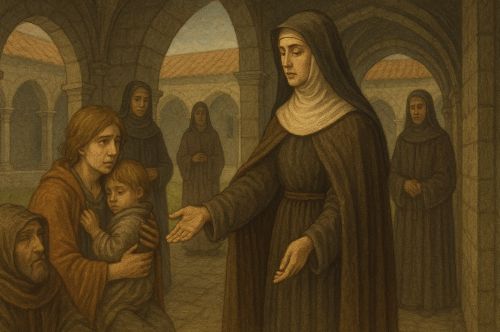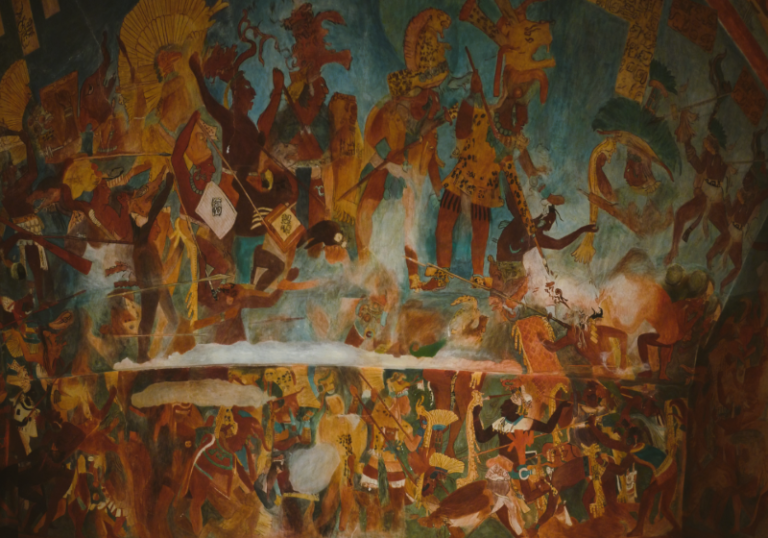

The medieval church’s sanctuary reminds us that societies measure their justice not only in the punishments they mete out but in the protections they afford the vulnerable.

By Matthew A. McIntosh
Public Historian
Brewminate
Introduction: Sanctuary as a Social Grammar of Mercy
A man runs at night, hunted. He grips the iron ring of the church door, pushes through, and collapses beneath the altar. The chase ends not with capture but with silence, for the ground he touches has become untouchable.
Medieval churches stood not merely as architectural testaments to divine authority but as practical arbiters of safety, their walls bearing a juridical and spiritual weight that extended beyond liturgical function. Sanctuary was a doctrine at once theological and legal, born of biblical precedent and refined through canon law, but its lived practice spoke to deeper anxieties of a fractured society.
It was not only the accused felon who fled to the church’s threshold, clutching the ring of the altar, but also the migrant laborer displaced by famine, the stranger hunted for his accent or garb, and the refugee cast out by political convulsions. The sanctuary door was both a boundary and a bridge, dividing sacred from profane yet permitting passage into a realm where violence was arrested. The act of crossing into sanctuary was therefore both ritual gesture and political statement, dramatizing the tension between human law and divine mercy.
The medieval sanctuary thus must be read as both a legal fiction and cultural practice, one which offers historians a window into the complex negotiation between ecclesiastical authority, secular power, and the vulnerable communities who slipped between their jurisdictions. The problem was not simply one of shelter but of who counted as worth sheltering. In tracing the sanctuary’s reach beyond criminals to immigrants and outsiders, we uncover how the medieval church articulated a fragile but radical theology of hospitality, refracted through the social and political crises of its time.
The Juridical Foundations of Sanctuary

The origins of sanctuary can be traced to Roman law and biblical injunction alike, where sacred spaces were conceived as inviolable. Exodus declared that the altar was a place to which the guilty might cling for protection, although exceptions existed for those accused of murder.1 Early Christian communities adapted this principle, and by the early medieval period sanctuary was recognized in both canon and secular law. In England, the law codes of King Æthelberht already recognized the immunity of churches, assigning fines for violations of their peace.2
By the twelfth century, sanctuary had become a defined right: one who reached the church could claim protection for a fixed period, often forty days, during which secular authorities were barred from entry.3 Yet these juridical boundaries only partially explain the phenomenon. Sanctuary was not simply a legal loophole but a theological assertion of the church’s sovereignty over the fate of souls. In claiming sanctuary, the fugitive invoked the idea that mercy was not the prerogative of kings alone but of God, mediated through His house on earth.
Criminals, Outsiders, and the Fluidity of Sanctuary
The standard narrative of sanctuary privileges the criminal: thieves, debtors, or killers seeking to delay punishment. Chronicles describe notorious cases in which sanctuary allowed dangerous men to evade immediate justice. Yet to imagine sanctuary as the exclusive recourse of criminals is to flatten its historical range. Parish records, episcopal statutes, and anecdotal narratives attest to the arrival of those who were not legally guilty but socially suspect: travelers without kinship ties, seasonal laborers in hostile markets, Jews and converts navigating precarious toleration, and immigrants marked by dialect or dress.4
The medieval city was porous yet vigilant. Outsiders were necessary to its economy yet constantly rendered suspect. Guilds jealously guarded their privileges, municipalities restricted citizenship, and migrants were often cast as scapegoats during economic downturns. For such individuals, the church offered a peculiar kind of conditional belonging. To seek sanctuary was to reposition oneself, even temporarily, from alien to protected.
This dynamic was especially fraught in border regions where ethnicity, religion, and politics collided. In these liminal zones, sanctuary functioned less as a mechanism for criminals than as a desperate lifeline for refugees of war and famine. Testimonies suggest that immigrants sometimes sought sanctuary preemptively, anticipating hostility from townspeople before a formal accusation ever arose. The church door, in this sense, became a threshold of pre-emptive defense.
At the same time, secular authorities frequently resented such uses of sanctuary. For kings and councils, immigrants were necessary but destabilizing; to allow the church to harbor them was to cede control over demographic tensions. The sanctuary of the outsider thus illustrates how medieval ecclesiastical power could extend into questions of identity, mobility, and belonging in ways that unsettled the secular order.
The Theology of Hospitality

The church’s embrace of sanctuary for outsiders drew upon long-standing Christian traditions of hospitality. Monastic rules enjoined brothers to receive the stranger as Christ Himself, invoking the parable of Matthew 25 where Jesus is identified with the hungry, the naked, and the imprisoned.5 This theology collided with the practical needs of parishes facing waves of displaced peoples. Bishops and abbots were not naïve to the dangers of harboring criminals, but they also recognized in the refugee or immigrant a figure of Christ’s own exile.
Hospitality, however, was not uniform. It was always circumscribed by power and circumstance. Some monasteries became famous for their charity, while others jealously guarded their doors. To offer sanctuary was to assert ecclesiastical jurisdiction over the secular sword, and conflicts abounded between bishops who defended their churches’ rights and kings who sought to curtail them. For the vulnerable outsider, these disputes mattered less than the chance to survive, but for the historian they reveal a theology not of abstract compassion but of contested sovereignty.
Case Studies: England and Beyond
A bell tolls at Durham. The townspeople know what it means: another fugitive has crossed the threshold, his life suspended by the stones of the cathedral. To enter is to step outside ordinary time, into a legal and spiritual parenthesis.
In England, the system of “chartered sanctuaries” revealed how the church institutionalized this protection. Certain cathedrals and abbeys, such as Durham and Westminster, became famed for their sanctuaries, attracting not only criminals but itinerant migrants whose presence in the city aroused suspicion.6 These sites evolved into semi-permanent communities, sometimes resembling enclaves of the socially marginal. Sanctuary here was less a brief respite than a negotiated form of existence.
On the Continent, sanctuary operated in more fluid forms. In France and Germany, village churches often served as ad hoc sanctuaries for refugees fleeing feudal wars or foreign raids.7 Chronicles describe peasants and travelers crowding into chapels as armies approached, with even local lords hesitating to violate consecrated ground. The phenomenon was decentralized but no less potent: a rural parish could, for a night, become a fortress.
Spain presents a still more complex picture. Amid the shifting frontiers of Christian, Muslim, and Jewish communities, sanctuary took on interreligious dimensions. Refuge could be sought across confessional lines, and accounts survive of Jews or Muslims rushing to churches in times of riot, confident that the sanctity of the site outweighed immediate hostility. In such moments, sanctuary revealed itself as an imperfect but real suspension of sectarian animosity.
Not all cases were celebrated. Critics charged that sanctuaries were misused by the unworthy, that churches shielded not the innocent immigrant but the hardened outlaw. Yet this very ambiguity demonstrates the elasticity of the institution. To condemn abuses was to admit that sanctuary had become indispensable; if it were trivial, no one would contest it.
The comparative range of these examples underscores that sanctuary was never a monolith. It was local, improvisational, and embedded in the texture of each society. Yet across Europe, one common theme emerges: the church acted where secular institutions faltered, offering protection not merely to criminals but to those whose very identity placed them at risk.
Decline and Legacy

By the late Middle Ages, monarchs increasingly curtailed sanctuary rights, perceiving them as challenges to centralized justice. Statutes under Henry VIII limited sanctuary privileges, confining them to specific churches and excluding certain crimes.8 This tightening reflected both frustration with abuses and the growing assertion of state sovereignty over the church.
Yet even as legal sanctuary waned, the idea of the church as a haven for the vulnerable persisted. The refugee and immigrant remained part of its moral imaginary, shaping later Christian activism in offering aid to displaced peoples. Medieval sanctuary, though dismantled, seeded traditions of asylum that echo in debates over migration and humanitarian protection today.
Conclusion: Sanctuary as Historical Mirror
Picture the threshold: a figure pressed against a wooden door, breathless, listening as soldiers mutter outside but do not cross. For a fleeting moment, safety is defined not by walls or weapons but by ritual and belief.
To examine medieval sanctuary only through the lens of crime is to miss its wider cultural resonance. Churches were not merely shelters for lawbreakers but fragile havens for those whom society deemed expendable. The immigrant, the traveler, the displaced outsider all found in sanctuary a provisional recognition of dignity.
In an age defined by porous borders yet fierce localisms, sanctuary was both a theological claim and a social experiment: a way to imagine community beyond the rigid lines of blood, law, and privilege. What took place at the threshold of a church was never only about law; it was about redefining who counted as a member of the human community, if only for a brief interval.
The medieval church’s sanctuary reminds us that societies measure their justice not only in the punishments they mete out but in the protections they afford the vulnerable. For medieval Europe, that protection often came not from the crown but from the church door, swung open to the desperate.
Appendix
Footnotes
- Exodus 21:13–14.
- Oliver J. Thatcher and Edgar Holmes McNeal, eds., A Source Book for Medieval History (New York: Scribner’s, 1905), 35.
- Karl Shoemaker, Sanctuary and Crime in the Middle Ages, 400–1500 (New York: Fordham University Press, 2011), 87–91.
- William Chester Jordan, The Great Famine: Northern Europe in the Early Fourteenth Century (Princeton: Princeton University Press, 1996), 122–125.
- Benedict of Nursia, The Rule of Saint Benedict, trans. Timothy Fry (Collegeville: Liturgical Press, 1981), chap. 53.
- Steven Pope, “Sanctuary: The Legal Institution in England,” University of Puget Sound Law Review 10, no. 677 (1987): 678.
- Barbara H. Rosenwein, Negotiating Space: Power, Restraint, and Privileges of Immunity in Early Medieval Europe (Ithaca: Cornell University Press, 1999), 203–208.
- J. H. Baker, An Introduction to English Legal History (London: Butterworths, 1971), 514–516.
Bibliography
- Baker, J. H. An Introduction to English Legal History. London: Butterworths, 1971.
- Benedict of Nursia. The Rule of Saint Benedict. Translated by Timothy Fry. Collegeville: Liturgical Press, 1981.
- Jordan, William Chester. The Great Famine: Northern Europe in the Early Fourteenth Century. Princeton: Princeton University Press, 1996.
- Rosenwein, Barbara H. Negotiating Space: Power, Restraint, and Privileges of Immunity in Early Medieval Europe. Ithaca: Cornell University Press, 1999.
- Shoemaker, Karl. Sanctuary and Crime in the Middle Ages, 400–1500. New York: Fordham University Press, 2011.
- Thatcher, Oliver J., and Edgar Holmes McNeal, eds. A Source Book for Medieval History. New York: Scribner’s, 1905.
- Pope, Steven. “Sanctuary: The Legal Institution in England.” University of Puget Sound Law Review 10, no. 677 (1987): 677-697.
Originally published by Brewminate, 08.25.2025, under the terms of a Creative Commons Attribution-NonCommercial-NoDerivatives 4.0 International license.


